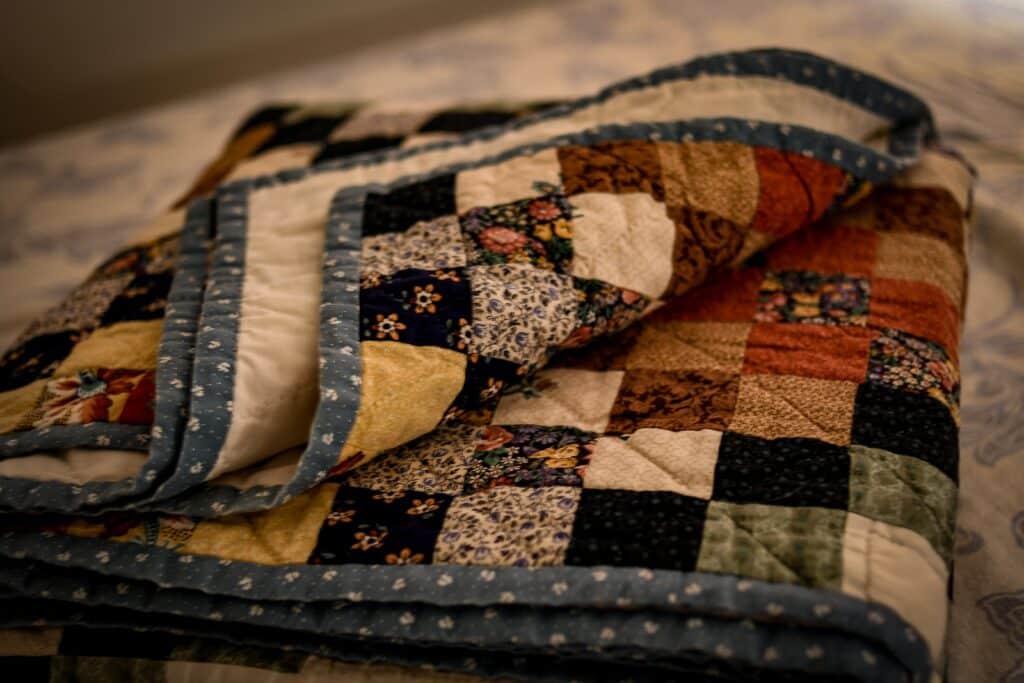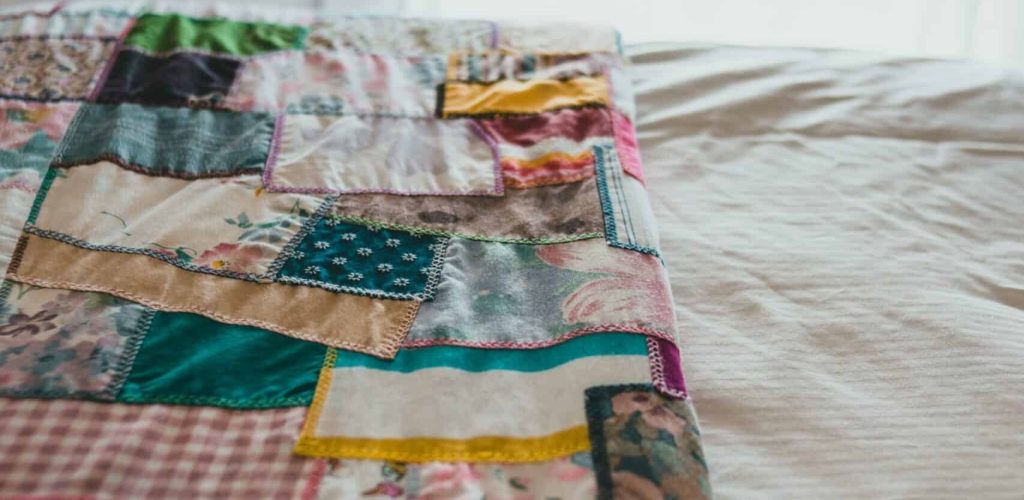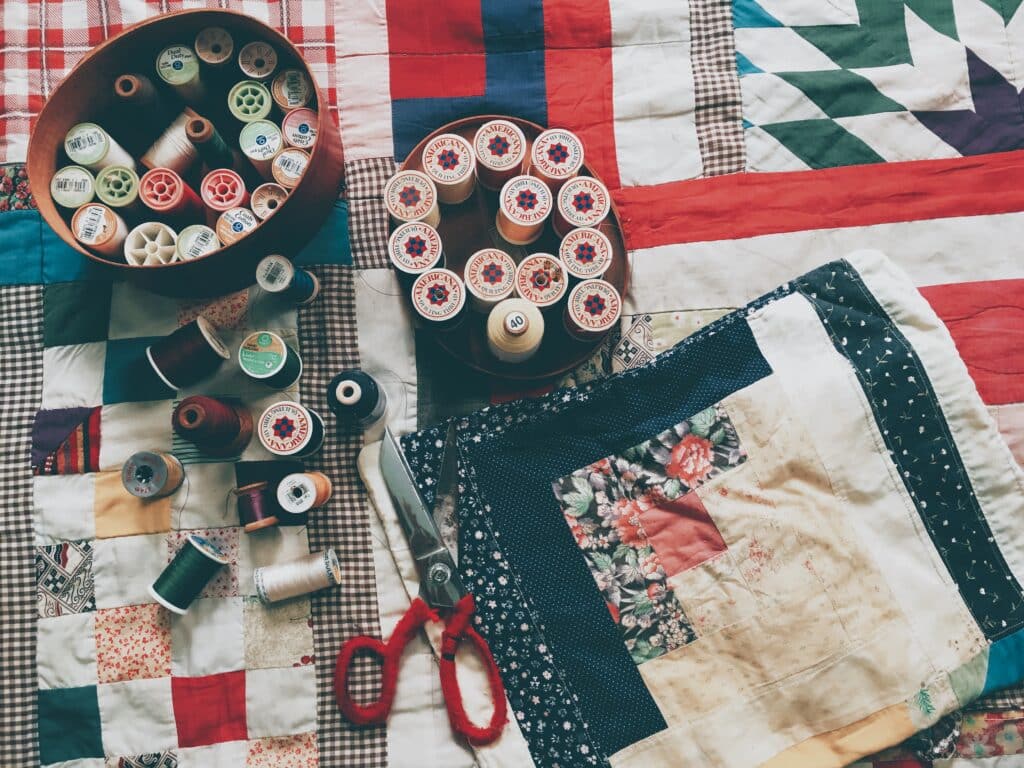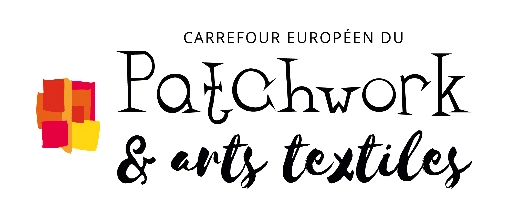Quiltmaking is an age-long needlework technique, generally associated with patchwork, to create a warm and thick piece of fabric.
Quiltmaking
To make a quilt, you need to sew together 3 layers of fabric, which include a central, filling layer, to create a dense piece that will keep you warm.
The top layer is commonly made out of a patchwork to obtain a beautiful pattern that will decorate the home.
Difference with patchwork
A patchwork may not be made of several layers. By simply sewing together several pieces of cloth, you are creating a patchwork.
The origins of quiltmaking
Quiltmaking is sometimes attributed to the Amish. Similarly to patchwork, it is actually a very ancient needlework technique which dates back several centuries and traces from Mesopotamia and India.
Quilt developed much later in Europe. It first appeared in Italy, then in the South of France—where it can be linked to the boutis of Marseilles, or Provençal quilting, registered since 2019 as an intangible cultural heritage of France—and finally in England.
The Amish women discovered this textile art in the 19th century. It perfectly fits their way of life. By recycling pieces of cloth, a quilt turns into a thick and warm bedspread.
The Amish women work together in a community. They usually make a quilt to celebrate important events, such as a wedding or a new birth. Quilting can also be used to help a member of the community who can no longer afford to pay their bills or their medical expenses.
The Amish quilt was popularized by its unique style and its patterning: the Irish chain, the sunshine and shadow, the log cabin, the Carolina lily, or the double wedding ring patterns.


What to make from a quilt
In its traditional form, a quilt is a simple and practical bedspread. It is used to stay warm and to spare money by reusing old clothes and scraps of fabric.
Nowadays, quilting has been modernized and adapted to the latest trends.
Of course, you can create quilted blankets and bedspreads with traditional designs and patterns.
But you can also let your inspiration flow and create all kinds of quilted pieces, items and accessories: bags, jackets, cushions…
Today’s patterns, shapes and colors are incredibly diverse, and the most beautiful works are true pieces of art. You can imagine and create anything with quilting, there are patterns for every style.
Already common in the USA, the modern quilts are reaching France and settling in our homes in new, reinvented ways, as pieces of textile art, sometimes framed on our walls.
Quilting techniques and styles
There are many ways and techniques to quilt.
Here are a few to introduce you to this art!
Hand-Quilting
A traditional and agelong method, quilting by hand requires a lot of patience.
This technique takes a lot of time. To make one piece, especially a large and complicated one, you will need a lot of work.
However, it can also be a quick and cheap way to try out quilting without investing in a sewing machine.
Becoming able to hand-stitch beautiful lines on a large piece of fabric comes with a lot of practice and experience.
With time and practice, everyone develops a singular stitching signature and a personal style. For the Amish, stitching is like writing: unique to each person! And connoisseurs are able to identify and recognize one’s specific style.
Machine Quilting
A sewing machine can also be used to work faster and with more efficiency.
There is no specific model designed exclusively for quiltmaking, most sewing machines will be perfectly adapted.
Free Motion Quilting
This technique is a bit more difficult to grasp if you are just beginning to quilt.
In it, the quilt can be moved freely in all directions. This way, the sewer has a lot more liberty to move around and to be creative. It allows for very detailed and complicated shapes and patterns.
It takes a lot of practice to master Free Motion Quilting.
Piecing
Piecing is probably the first technique that comes to mind when it comes to patchwork or quiltmaking.
It consists in arranging several straps of fabric of various shapes and colors before sewing them together to create a pattern.
Appliqué
Appliqué (which means “applied” in French) as a technique consists in sewing pieces of cloth on top of others. A first, large piece of fabric is used as the bottom layer and as the background.
Then, smaller scraps are sewn on top of it to create a pattern.
Quilt Improv
As suggested by its name, this technique consists in sewing together scraps of fabric of different colors, shapes and sizes in a spontaneous way.
There is no fixed pattern or design, the creator follows their inspiration.
The result is a totally unique piece, often brightly colored.

